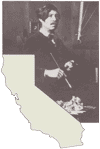![]()

Five Views: An Ethnic Historic Site Survey for California
MENU
Introduction
Mexican War
Post-Conquest
1900-1940
World War II
Chicano Movement
Future
Historic Sites
Selected References

A History of Mexican Americans in California:
HISTORIC SITES
Dodson's Rooming House Site
Sacramento, Sacramento County
Dodson's Rooming House in Sacramento was Ernesto Galarza's first home in the United States when he and his mother arrived from Jalcocotan, Mexico, in 1913, to join his uncles, Gustavo and Jose Galarza. Within the environs of this rooming house and the surrounding community, and under the influence of the family who loved and disciplined him and the multi-ethnic people who befriended and taught him, Ernesto Galarza, future economist, educator, scholar, and activist, formed his first impressions of California and the United States. These first formative years, spent among working people, immigrant and nonimmigrant alike, Mexican, Italian, Asian, Black, and native-born Anglos, as well as his rural Mexican roots, would become the basis for Galarza's life-long commitment to education and social justice. "Little Ernie," as he was called, was seven years old when he moved to Dodson's Rooming House. The family lived there for four years. Galarza's youth in Sacramento is described i n Barrio Boy (Ballantine, 1971), one of the few autobiographies by a Mexican American.
Among the Sacramentans who figured prominently in Galarza's educational formation was Miss Nettie Hopely, principal of Lincoln School, where Galarza received his first formal education in the United States. Galarza continued his education at Stanford University, where he completed a Master of Arts in Education, and at Columbia University, where he received a Ph.D. in economics. After completing his formal education in the 1930s, Galarza worked tirelessly to improve economic and social conditions for American workers.
A strong advocate of labor unions, he led early efforts to organize farmworkers in California agriculture. The history and politics of farm-labor organizing are skillfully narrated in his three exhaustively researched studies, Merchants of Labor (1964), Spiders in the House and Workers in the Fields (1967), and Agribusiness in California (1977).
Equally significant, Galarza's work as an inspiring teacher and educator is well known and highly respected in California. He taught at San Jose State University, was a visiting professor at U.C. San Diego (where he is a "life-long fellow"), and presented innumerable guest lectures at other universities, including Notre Dame, Stanford, and U.C. Berkeley. He was also the featured speaker at many conferences concerned with education and related issues. Professor Galarza served on numerous local, state, and national commissions and committees related to educational concerns. Of these, his work with the National Network of La Raza is probably the most important. Galarza's efforts on behalf of bilingual education are well known among educators and legislators. His Mini-Libros series, a collection of rhymes and poems which he composed, wrote, and published, is used in bilingual classrooms throughout the United States.
Often called the dean or statesman of Chicano scholarship, Galarza's significance as an educator, scholar, and social critic to the people of the state of California should be acknowledged. Dodson's Rooming House, Galarza's first home in California, has been demolished; the lot was paved and converted into a parking lot for a local financial institution in Sacramento.
NEXT> Durgan Bridge
Last Modified: Wed, Nov 17 2004 10:00:00 pm PDT
5views/5views5h27.htm
 Top
Top